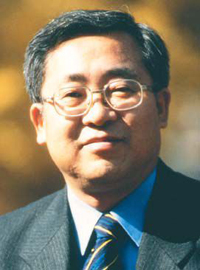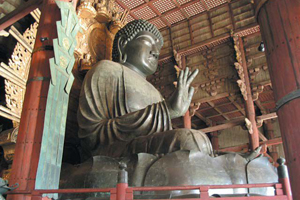NORTHEAST ASIAN HISTORY FOUNDATION 07/2010
-
Lee, Wu-tae Professor, University of Seoul
 Lee, Wu-tae
Lee, Wu-taeIt was during the Unified Silla period that trade relations with Japan flourished more than ever before. Most textbooks and introductory history books focus on trade relations with Tang China during the period, but trade between Unified Silla and Japan was also very active.
Based on Korean and Japanese historical records, there were 39 envoy dispatches from Silla to Japan and 25 envoy dispatches from Japan to Silla, respectively, between 670 and 779. Given that there were only 10 rounds of envoy dispatches from Japan to Tang China during the same period, we can see just how extensive trade relations were between Silla and Japan.
This is evident not just in the frequency of the envoy dispatches but also in terms what these dispatches entailed. For instance, a Japanese envoy to Silla was granted an audience with King Hyoso in March 698. Also, the Japanese delegation that came to see King Seongdeok in 703 was very large, consisting of 204 envoys. Kim Am [金巖], a descendant of Kim Yu-sin and an accomplished writer, and Seol Jung-eop [薛仲業], the son of Seol Chong, were among the envoys from Silla to Japan during this era, demonstrating that the envoy dispatches were not simply for trade relations but also played a key role in cultural exchanges.
The dazzling Silla artifacts in Shonsoin [正倉院] speak volumes about Silla's influence on the development of Japanese culture. The Japanese emperor also tried to get Kim Am to permanently stay in Japan, demonstrating Japanese enthusiasm for Silla culture.
Kim Tae-ryeom, who pretended to be a tributary envoy to facilitate trade
The most noteworthy incident involving the exchange of envoys was the Silla delegation to Japan in 752. Leading a delegation of some 700 is said to have been Kim Tae-ryeom, a Silla prince. The year 752 was when the inauguration ceremony for Todai-ji [Todai temple] in Nara Japan was held. Kim Tae-ryeom and the rest of the delegation used this celebratory event as an occasion for a visit. Although Japan might have exerted some pressure, the delegation acted as though it were a tributary delegation from Silla in order to facilitate a trade deal.
According to Shoku Nihongi [続日本紀], it was reported by Dazaifu (an administrative body in Kyushu) in March 752 (11th year of the reign of King Gyeongdeok) that "seven ships carrying a delegation of some 700 persons—including the Silla prince a kind of scholar-official, Daeacheokgan Kim Tae-ryeom; Kim Hwon, an envoy; and Kim Pil-eon, the prince's attendant—came to dock." It goes on to say that around three months later on June 14, "The Silla prince Kim Tae-ryeom, on behalf of the Silla king, bowed and paid tribute." It is recorded that on June 17, Japan threw a banquet for the Silla delegation at which the latter was told, "From now on, if the emperor cannot come in person, his envoys must bring an official document."
However, there is no mention of this incident in any of Korea's historical sources. Furthermore, there is no evidence supporting the claim that Kim Tae-ryeom was a Silla prince. Therefore, it is highly likely that Kim Tae-ryeom was an impostor; it is recorded in Samguk Sagi that although Japan had sent a delegation to Silla in February 753, the king refused to give the delegation audience and deported the group because of a Japanese envoy's rudeness and arrogance.
 Buddha statue in Todai-ji temple in Japan
Buddha statue in Todai-ji temple in JapanNational integrity should come before immediate gains
Maesillamulhae is an ancient text that sheds light on goods imported and exported by Silla. From it, we can learn that Silla exported spices, medicinal herbs, and other rare commodities to Japan. Of note, Silla probably made a large profit from selling Hyang-ya(drug stuffs) used at prayer services at Buddhist temples.
Some focus on such trade conditions and consider the Kim Tae-ryeom incident to have been a scam undertaken to deceive the Japanese government for large profits. Some even go so far as to say Kim Tae-ryeom was a man of impressive business acumen. However, the Kim Tae-ryeom incident had a major impact on the Japanese ruling class' perception of Korea. That is, Japan came to regard Silla as Japan's tributary state.
During that period, Silla was not only referred to as a Japan's tributary state) but Japan also attempted to make this known to other countries. For instance, in 753, a Japanese envoy claimed that "Silla was Japan's tributary state" to Emperor Xuanzong of Tang. Thus, Kim Tae-ryeom's scam played a major role in fostering Japan's incorrect perception of Korea.
In 735, Tang acknowledged that that the territories south of Daedong River belong to Silla. As a result, the diplomatic relations between the two countries improved, and Silla began claiming a higher status than Japan. Thereafter, relations between Silla and Japan grew even more distant. Nevertheless, Japan's incorrect understanding of Korea formed during this period came to exercise a huge influence on the generations that follow. Japan's sense of superiority vis-à-vis Korea is evidenced in Toyotomi Hideyoshi's invasion of Korea. It is startling to find that this perception had been even been passed down to the Japanese leaders at the time of Japan's annexation of Korea a century ago.
The Kim Tae-ryeom incident should serve as a lesson, warning us to be wary of doing something for immediate gains that may disadvantage future generations. That is, while immediate gains may be important in international relations, we should always think about whether these gains serve a justifiable purpose. Therefore, whether in dealing with the Northeast Project, Dokdo's sovereignty, or any other issues of regional historical conflict, we should not compromise national integrity for immediate gains. This is something to keep in mind when compiling the textbook on East Asian history, which will be included in Korea's high school history curriculum as of 2012. That is, we must strive to instill a sound perception of history in our youth, who will shape the future.


